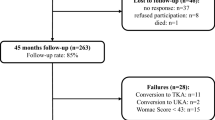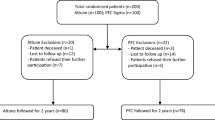Abstract
Purpose
To prospectively evaluate the clinical and radiographic outcomes and survivorship at 2 and 5 years after isolated contemporary patellofemoral inlay arthroplasty.
Methods
Thirty-four patients were prospectively enrolled in the study and were evaluated preoperatively and at 2 and 5 years postoperatively. Clinical outcomes included the Western Ontario and McMaster Universities Osteoarthritis Index (WOMAC) score and the visual analogue scale (VAS) for pain. Kellgren-Lawrence grading was used to assess the progression of tibiofemoral osteoarthritis and the Caton-Deschamps Index to determine patellar height. A Kaplan–Meier survival analysis was used to investigate the implant survivorship. Preoperative patient characteristics were compared among failures and success to determine potential risk factors and patient satisfaction was rated postoperatively.
Results
Five of the 34 patients were lost to follow-up resulting in a final follow-up rate of 86%. The total WOMAC subscores of pain and function and the VAS Pain improved significantly at 2- and 5-years, with no significant difference between the two time points. The WOMAC stiffness subscale reached significant improvement at 2-year follow-up alone. No significant progressions of tibiofemoral arthritis or changes in patellar height were observed. A total of six patients (17.1%) failed leaving a survival rate of 91% after 2 years and 83% after 5 years. The main cause for postoperative failure was persistent knee pain; however, no significant preoperative risk factor in patient characteristics could be identified.
Conclusion
Patellofemoral inlay arthroplasty shows high patient satisfaction with significant improvement in knee function and pain relief after mid-term follow-up with no radiographic progression of tibiofemoral OA.
Level of evidence
Prospective case series, Level III.



Similar content being viewed by others
References
Bellamy N, Buchanan WW, Goldsmith CH et al (1988) Validation study of WOMAC: a health status instrument for measuring clinically important patient relevant outcomes to antirheumatic drug therapy in patients with osteoarthritis of the hip or knee. J Rheumatol 15:1833–1840
Blazina ME, Fox JM, Del Pizzo W et al (1979) Patellofemoral replacement. Clin Orthop Relat Res 144:98–102
Cartier P, Sanouiller JL, Khefacha A (2005) Long-term results with the first patellofemoral prosthesis. Clin Orthop Relat Res 436:47–54
Caton J, Deschamps G, Chambat P et al (1982) Patella infera. Apropos of 128 cases. Rev Chir Orthop Reparat Appar Mot 68:317–325
Escobar A, Quintana JM, Bilbao A et al (2007) Responsiveness and clinically important differences for the WOMAC and SF-36 after total knee replacement. Osteoar Cartil 15:273–280
Feucht MJ, Cotic M, Beitzel K et al (2017) A matched-pair comparison of inlay and onlay trochlear designs for patellofemoral arthroplasty: no differences in clinical outcome but less progression of osteoarthritis with inlay designs. Knee Surg Sports Traumatol Arthrosc 25:2784–2791
Gould D, Kelly D, Goldstone L et al (2001) Examining the validity of pressure ulcer risk assessment scales: developing and using illustrated patient simulations to collect the data. J Clin Nurs 10:697–706
Imhoff AB, Feucht MJ, Meidinger G et al (2015) Prospective evaluation of anatomic patellofemoral inlay resurfacing: clinical, radiographic, and sports-related results after 24 months. Knee Surg Sports Traumatol Arthrosc 23:1299–1307
Kellgren JH, Lawrence JS (1957) Radiological assessment of osteo-arthrosis. Ann Rheum Dis 16:494–502
Laursen JO (2017) High mid-term revision rate after treatment of large, full-thickness cartilage lesions and OA in the patellofemoral joint using a large inlay resurfacing prosthesis: HemiCAP-Wave(R). Knee Surg Sports Traumatol Arthrosc 25:3856–3861
Leadbetter WB, Ragland PS, Mont MA (2005) The appropriate use of patellofemoral arthroplasty: an analysis of reported indications, contraindications, and failures. Clin Orthop Relat Res 436:91–99
Lubinus HH (1979) Patella glide bearing total replacement. Orthopedics 2:119–127
Mckeever DC (1955) Patellar prosthesis. J Bone Joint Surg Am 37-A:1074–1084
Outerbridge RE (1961) The etiology of chondromalacia patellae. J Bone Joint Surg Br 43-B:752–757
Patel A, Haider Z, Anand A et al (2017) Early results of patellofemoral inlay resurfacing arthroplasty using the HemiCap Wave prosthesis. J Orthop Surg (Hong Kong) 25(1):2309499017692705
Pisanu G, Rosso F, Bertolo C et al (2017) Patellofemoral arthroplasty: current concepts and review of the literature. Joints 5:237–245
Zicaro JP, Yacuzzi C, Astoul Bonorino J et al (2017) Patellofemoral arthritis treated with resurfacing implant: Clinical outcome and complications at a minimum two-year follow-up. Knee 24:1485–1491
Funding
No external funding was used.
Author information
Authors and Affiliations
Contributions
All authors contributed in a significant way in the steps of processing the patient history as well as writing and editing the manuscript. ABI and JP conceived of the idea for the study/publication and made substantial contributions to conception and design. MF and MC were engaged in writing the manuscript, provided research support and ethical approval. EB collected patient data and provided figures. All authors read and approved the final manuscript.
Corresponding author
Ethics declarations
Conflict of interest
Andreas Imhoff is consultant for arthrosurface. All other authors have no conflict of interest.
Ethical approval
Institutional Review Board (IRB): ethical approval (No. 419/13).
Rights and permissions
About this article
Cite this article
Imhoff, A.B., Feucht, M.J., Bartsch, E. et al. High patient satisfaction with significant improvement in knee function and pain relief after mid-term follow-up in patients with isolated patellofemoral inlay arthroplasty. Knee Surg Sports Traumatol Arthrosc 27, 2251–2258 (2019). https://doi.org/10.1007/s00167-018-5173-2
Received:
Accepted:
Published:
Issue Date:
DOI: https://doi.org/10.1007/s00167-018-5173-2




